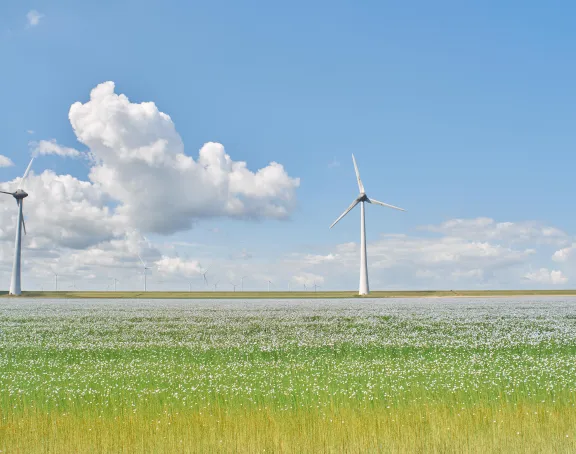The Climate and Energy Memorandum 2025 and the recommendations of the Advisory Division
On Prinsjesdag, a traditional moment for the Dutch Government to present the annual budget and other policy plans for the following year, the government presented the 2025 Climate and Energy Memorandum. A draft version of this was submitted by the Minister for Climate and Green Growth to the Advisory Division of the Council of State (‘Division’) for advice. The Advisory Division published a critical opinion on 16 September 2025. In this publication, we discuss the Advisory Division's opinion and the 2025 Climate and Energy Memorandum.
Background: the Climate and Energy Memorandum and the Division's opinion
Following a critical opinion from the Division on the draft Climate Plan 2025-2035 in March 2025 (more on this in this blog), the Division issued another opinion on Dutch climate policy on 16 September 2025. This time, the opinion concerns the draft Climate and Energy Memorandum 2025.
Pursuant to Article 7 of the Climate Act, the government draws up an annual climate memorandum. In this memorandum, the government reports on the climate and energy policy it has pursued and on the progress made in the past year. Article 7(4) of the Climate Act stipulates that the Division must be consulted on the climate memorandum. The Division does so partly in light of the figures presented by the Netherlands Environmental Assessment Agency (‘Planbureau voor de Leefomgeving’ PBL) in its annual Climate and Energy Outlook (‘Klimaat en Energie Verkenning’ KEV) (see Article 6 of the Climate Act).
The Climate and Energy Memorandum 2025 is the first memorandum in which climate and energy policy is presented by the government in a coherent manner. Because climate and energy policy interact with each other, the government has decided, in line with recommendations from the House of Representatives and the Division, to combine these documents (Climate and Energy Memorandum 2025, p. 4).
Main points of the Climate and Energy Memorandum 2025
In the Climate and Energy Memorandum 2025, the government emphasises that the climate and energy transition is one of the fundamental challenges of our time, which has become more urgent due to developments in the world in recent years. The outgoing government therefore remains committed to the climate and energy transition.
The KEV 2025 shows that the PBL expects a CO2 reduction of 46.8-54.5% in 2030. This means that the 55% CO2 reduction target for 2030 is just outside the bandwidth. The government has indicated that it will continue to focus on implementation, preconditions and logical steps in the sectors in order to achieve the 2030 target. The 2025 Climate and Energy Memorandum states that the government is therefore taking action to make the construction of offshore wind farms more attractive, to bring together supply and demand for renewable electricity, and to strengthen the basis for sustainability in industry through electrification.
The government is also focusing on a future-proof economy and a resilient energy system with greater energy independence. Electrification remains the main route for industry, but there will also be companies that need hydrogen as an energy source or raw material. In the long term, there will be more emphasis on importing hydrogen-rich energy carriers rather than domestic production, as production will remain cheaper in other countries for longer than expected.
The Climate and Energy Memorandum 2025 contains six chapters that deal with the following topics in succession: (1) the main developments in the field of climate and energy, (2) the scope of decarbonisation, renewable energy and energy saving, (3) greenhouse gas reduction per sector, (4) (developments in) the energy system, (5) cost control of the energy transition, and (6) the horizontal themes of space, balanced approach to safety and health risks, critical raw materials and just transition. The following appendices have also been added to the 2025 Climate and Energy Memorandum: a government-wide overview of climate and energy expenditure, a climate policy legislative programme, the Government's response to the Council of State's considerations, and a memorandum on the costs of inaction in climate and energy policy.
Advice from the Division
The Division notes that, when it comes to achieving its climate targets, the Netherlands is making little progress towards meeting its 2030 targets. There is less than a 5% chance that the national climate target of a 55% reduction in emissions by 2030 compared to 1990 will be achieved. In fact, according to the Division, this stagnation means that there has been a decline, because greater steps will have to be taken in the future to still achieve the climate targets, which could lead to higher costs and declining prosperity. The Division also points to the government's 'retreat' and gives as an example the downward adjustment of expected power from offshore wind (from 50 GW of offshore wind in 2040 to 30-40 GW of offshore wind) and the scaling back of commitments in the field of green hydrogen production. According to the Division, the draft memorandum does not reflect the urgency needed to get on track to achieve the climate targets, and problems are being postponed, especially now that affordability has become an important and decisive criterion for the further shaping of climate policy. The Division believes that it is necessary to pursue a binding, consistent and predictable climate policy now in order to achieve the targets, and that delaying climate policy is not appropriate in this regard.
The Division makes several recommendations and points out, among other things: (1) making clear, climate-proof choices for the short, medium and long term in a timely manner, (2) putting the energy infrastructure in order, (3) focusing attention on new, innovative economic activity, (4) the scarcity issue, (5) conducting a socio-economic structural analysis, and (6) climate justice and behavioural change.
Below, we discuss these recommendations from the Division. For each component, we then examine whether and to what extent the Government has adjusted the 2025 Climate and Energy Memorandum accordingly.
1. Timely, clear, climate-proof choices for the short, medium and long term
The Division emphasises the importance of making concrete, guiding choices in a timely manner about what needs to be done in the short, medium and long term, and also points to the importance of timely and adequate implementation of existing climate policy. The Division also mentioned this earlier in its consideration of 3 March 2025 on the draft Climate Plan. Unstable climate policy makes it unclear to businesses what incentives there will be for further sustainability and to what extent the government will facilitate them. The risk of short-term thinking and downward adjustment of ambitions is that this slows down climate policy and may be at the expense of support in the longer term.
The government's response, included in Appendix 3 of the Climate and Energy Memorandum 2025, emphasises that the challenges and scale of the transition require choices to be made and a degree of agility and flexibility. With regard to, for example, the downward adjustment of power from offshore wind (from 50 GW to 30-40 GW in 2040), rising costs and uncertainty about electricity demand are cited as obstacles for developers. The government defends the adjustment of power from offshore wind criticised by the Division with the argument that the realisation of 40 GW at sea still amounts roughly to an eightfold increase in current production capacity. This adjustment from the draft memorandum has therefore been retained in the final Climate and Energy Memorandum 2025 (see pp. 8 & 41).
2. Energy infrastructure must be in order
In its advice, the Division states that it is important to establish preconditions for further sustainability, such as the realisation of an adequate energy infrastructure, . This also follows from the Impact Analysis Climate Plan 2025-2035 , carried out by CE Delft, which examined the qualitative consequences of the Climate Plan 2025-2035 for households, businesses, the economy, and its effects on broad prosperity and employment. Addressing grid congestion is a high priority for the government. At the same time, the Division emphasises that there is no indication of any substantial acceleration as a result of the announced acceleration package to shorten lead times for high-voltage routes. It is unclear whether the acceleration package will be sufficiently effective, as delays in decision-making appear to be partly caused by the nitrogen issue. The Division therefore recommends that other solutions to the congestion problem also be explored.
The government does not appear to have made any concrete additions to the final Climate and Energy Memorandum 2025 on the basis of this part of the Division's advice. In its response to the Division's opinion, the government states that it remains fully committed to implementing the acceleration package. With regard to the urgency of reducing net tariffs, as emphasised by the Division, the Government states that several options are being investigated and that these will be further elaborated as input for the formation of the new government(the current government has been ‘demissionary’ since June). The government also refers to the letter to Parliament of 25 April 2025 on the faster expansion of the electricity grid.
3. Focusing climate policy on new, innovative activities – aligning with European initiatives
In the field of innovation, the Netherlands is focusing on the overarching European target of investing 3% of gross domestic product (GDP) in research and development (R&D). However, achieving this 3% target is still a long way off: in 2023, only 2.2% of GDP was invested in R&D, and this is expected to fall to 2% in 2030.
In its advice, the Division notes that it is important to encourage and facilitate promising, innovative activity. This can be done by responding to initiatives and opportunities offered at European level, such as the State Aid Framework Clean Industrial Deal, the European Innovation Fund and the EU initiative Horizon Europe. The Division emphasises that it is important to exploit synergies in national and European innovation policy and, in general, to join European initiatives in a timely manner.
The government acknowledges the importance of innovation in the final Climate and Energy Memorandum 2025, but makes no additional financial commitments beyond the current subsidy framework, nor does it mention the target percentage of 3% for investment in innovation. In its response to the Division's advice, the government states that the scope offered by the Clean Industrial Deal for establishing new, innovative businesses must be optimally utilised. At the same time, it explicitly states that this government will not make any choices about which activities are or are not appropriate in an economy focused on green growth. The government emphasises the importance of existing activities for Dutch and European resilience and strives to make them as sustainable as possible.
4. The scarcity problem (with regard to space, labour, materials and financial resources)
The Division cites the scarcity problem with regard to space, labour, materials and financial resources as one of the obstacles to sustainability. In its consideration of the draft Climate Plan, for example, it discussed the problem of structural shortages in the labour market and pointed to the limited availability of physical space. With regard to physical space, for example, the Division indicates that it is important to devise solutions that can limit the use of space, which will sometimes require creative solutions, and that it is also important to involve local residents as much as possible. These various factors mean that choices have to be made about where and how people, resources and space are deployed, according to the Division. The Division therefore recommends that climate and energy policy respond to this.
In our opinion, the Division does not make it entirely clear what it considers to be the shortcomings in the draft memorandum with regard to scarcity issues. The government's response emphasises that space, resources and people are also seen as an integral theme. The final Climate and Energy Memorandum 2025 shows that the government has introduced concrete policies on both the themes of space and labour market shortages, such as the Multi-year Infrastructure, Energy and Climate Programme and the Green and Digital Jobs Action Plan.
5. Socio-economic structural analysis
In its consideration of the draft Climate Plan 2025-2035 and its advice on the draft Budget Memorandum 2026, the Division already pointed out the importance of basing climate policy on a socio-economic structural analysis, with an emphasis on the spatial dimensions of climate policy. The Division now reiterates the importance of conducting a socio-economic structural analysis, as the choices made and the assumed effects of the government's plans for industry are not currently based on clear research. The Division cites as an example the government's decision to build two new nuclear power plants, without placing this development in the broader context of the deteriorating market conditions for offshore wind and the lagging demand for electricity. The Division also misses an explanation of how the greater role expected by the Government for imports of hydrogen-rich energy carriers and semi-finished products should be seen in relation to the government's important goal of energy independence.
The government's response is brief and does not appear to have taken the Division's advice into account in the final Climate and Energy Memorandum 2025. A structural analysis was prepared in preparation for the 2026 Budget Memorandum, but it did not explicitly focus on sustainability or energy independence. Furthermore, the government does not indicate why it chose not to prepare a socio-economic structural analysis for the 2025 Climate and Energy Memorandum, despite various recommendations from the Division.
6. Climate justice and behavioural change
One of the ' horizontal themes' of the 2025 Climate and Energy Memorandum (themes that, according to the Government, affect various sectors and/or energy chains) is a just transition. The Division also advised on this in its consideration of the draft 2025-2035 Climate Plan. The government subsequently announced that it would develop indicators for the implementation of the various principles of justice. In addition, a government-wide 'generational test' was announced. Against this background, the Division notes that climate justice receives little attention in the draft memorandum. The status of the announced indicators for the principles of fairness, the generational test and the results of public consultation and citizen participation are hardly mentioned.
The theme of behavioural change and the corresponding policy mix required to achieve this are also barely mentioned in the draft memorandum. This is striking, given that the theme plays an important role in the Climate Plan 2025-2035.
In its response to the Division's advice, the government states that considerable steps have been taken with regard to climate justice since the draft Climate Plan 2025. However, the discussion of Just Transition in the final Climate and Energy Memorandum 2025 shows that many aspects are still in the research phase. With regard to the distribution of the costs of the transition, research is being conducted into how greater transparency can be provided about the distribution of these costs in policy, and the indicators for climate justice mentioned in the draft Climate Plan 2025-2035 must also be further operationalised and concretised. The generation test is not mentioned in the final Climate and Energy Memorandum 2025. However, more concrete measures, including at the European level, to combat energy and mobility poverty have been included in the memorandum. The government has not included the Division's proposals on behavioural change, such as measures to reduce meat consumption, in the final Climate and Energy Memorandum 2025.
Conclusion
The Division was critical of the draft Climate Plan 2025-2035 in March 2025. In an earlier blog post, we discussed the Division's advice and the Climate Plan 2025-2035 in more detail. At the time, we concluded that, despite the Division's recommendations, climate policy had been left largely open and that we hope that the climate memorandum would provide more clarity.
In the Climate and Energy Memorandum 2025, the government reported on the climate and energy policy pursued and on the progress made over the past year. In addition, the government has adjusted a number of plans in the Climate and Energy Memorandum 2025 (downwards), as these plans proved to be unworkable or unachievable at the desired pace (see the letter to parliament concerning the implementation of the Green Growth Package). However, the government does not elaborate on what this means for achieving the climate targets and the affordability of the transition task, while the Division emphasises, among other things, that delaying action is not in line with the need to 'implement binding, consistent and predictable climate policy now'.
We also note that the government has been ‘demissionary’ and only functioning as a caretaker since 3 June 2025 and that the Climate Plan 2025-2035 has been placed on the House of Representatives' list of controversial topics. In the Netherlands after a government steps down, certain topics are declared controversial which means that the current government cannot create new policies on it anymore. This means that the Climate Plan for this period has not yet been adopted, and therefore there is no basis for concrete policy. However, it remains essential for businesses, citizens and others involved in the climate transition that the government takes the Division's call for a binding, stable, consistent and predictable climate policy to heart. This is the only way in which the Netherlands can achieve its climate targets for 2030 and 2050 and offer certainty to businesses.



